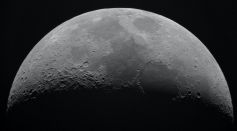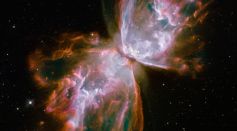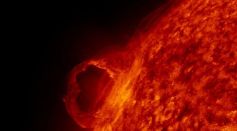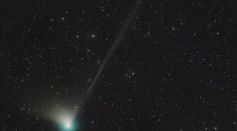Tags: Earth

South Korea's Lunar Orbiter 'Danuri' Releases Astonishing Photos of Moon, Earth; Spacecraft Continues Search For Potential Landing Sites
Earth, Moon’s Cislunar Space Is Becoming Overcrowded, May Result in War [Report]

Astronomers Detect Star System With Two Super-Mercuries and Three Super-Earths; How Rare Are These Planets?

Earth's Inner Core Could Be Reversing Its Direction, Slowing Down
NASA To Send 3 New Missions to Venus Over the Next 10 Years in an Attempt To Understand Why the Planet Is Earth’s Evil Twin

Flashes on the Sun's Upper Atmosphere Could Aid in Forecasting the Next Solar Flare, NASA Says
Martian Meteorite That Crashed on Earth Contains Organic Compounds That May Give New Insights About the Red Planet

Earth's Average Surface Temperature in 2022 Declared as the Fifth Warmest on Record Due to Worsening Climate Change

Hubble Space Telescope's Time-Lapse Images of Butterfly Nebula Explains How It Got Its Wings and the Sun's Final Fate
Football Field-Sized Asteroid, 4 More Moving Close to Earth in the Coming Days, NASA Warns

Huge Bubble of "Swiss Cheese" Surrounding Earth Has Now Been 3D Mapped For the First Time

Mars Could Have Been Capable of Fostering Life Way Before Earth

Earth Could Go Through Great Solar Storm With Strength of One Billion Hydrogen Bombs

Green Comet Will Soon Greet the Night Sky in Its First Appearance in 50,000 Years

Extraterrestrial Life Forms Might Be Waiting for the Right Time to Contact Earth, New Study Suggests

Sun Released Colossal X-class Solar Flare From Previously Hidden Unstable Sunspot That Is Now Facing Earth

UV Radiation May Have Been Involved in the End-Permian Mass Extinction Event, Fossil Analysis Reveals

NASA's SWOT Unfolds Itself in Space to Map Nearly All Water on Earth: Here Are 5 Things To Know About This Satellite

Bright Green Comet Last Seen 50,000 Years Ago Will Pass by the Sun and Earth This Year

Largest 'Potentially Hazardous' Near-Earth Objects Predicted To Have a Close Flyby in 2023
Most Popular

Recycling Myths vs Facts: What Actually Gets Recycled and How to Do It Right

Allergies Explained: What Happens in Your Body During an Allergic Reaction

What Is Conservation Biology? Key Strategies to Protect Species and Habitats

Types of Pollution: Air, Water, Soil, Noise, and Their Health Effects





